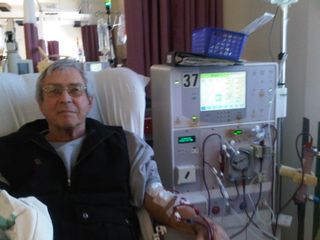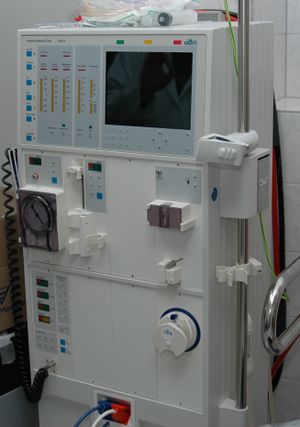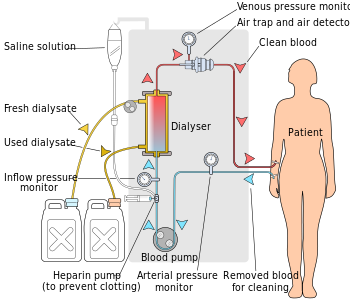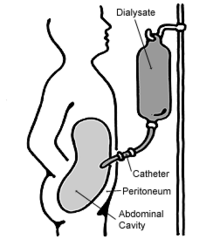غسيل كلوي
| غسيل كلوي | |
|---|---|
| تدخل | |
 مريض يجري الغسيل الكلوي. | |
| ICD-9-CM | 39.95 |
| MeSH | D006435 |
في الطب، الغسيل الكلوي dialysis، هو علاج يستخدم عند توقف كليتي الجسم عن العمل بشكل جيد، حيث تتم إزالة السوائل والفضلات الزائدة من الجسم. يتم خلال غسيل الكلى الدموي ضخ كميات صغيرة من الدم إلى خارج الجسم عبر جهاز يُسمى الكلى الصناعية.
يقوم جهاز غسيل الكلى بترشيح السوائل والفضلات الزائدة من الدم، وبعد ذلك يتم إرجاع الدم إلى الجسم. ويستغرق هذا العلاج حوالي أربع ساعات ويتم القيام به ثلاثمرات أسبوعيًا. ويلزم لهذا النوع من العلاج توافر موضع يتم سحب الدم منه ثم إرجاعه إلى دفق الدم. وهذا يطلق عليه موضع الوصول. وبعد تحديد موضع الوصول والتئامه، يتم إدخال إبرتين في موضع الوصول. ويتم سحب الدم إلى الخارج عبر إحدى الإبرتين بينما يتم إرجاع الدم إلى الجسم عبر الإبرة الأخرى.[1]
التاريخ
ساهم الكثير من الأشخاص في تطوير الغسيل الكلوي كعلاج للفشل الكلوي، بدءأ بتوماس گراهام من گلاسگو، الذي قدم لأول مرة مبادئ النقل المذاب عبر الأغشية شبه النافذة في عام 1854.[2] وكان أبل أول من قام بتطوير الكلى الصناعية في عام 1913،[3] وأول من أجرى عملية الغسيل الكلوي البشري كان هاس (في 28 فبراير 1924)[4] وقام كولف باستخدام أول جهاز غسيل كلوي سريريا في عام 1943 - 1945.[5] وقد أظهرت تلك الأبحث إمكانية إنقاذ حياة مرضى الفشل الكلوي.
كان د. ويليام كولف أول من قام بتصميم جهاز غسيل كلوي في عام 1943. وأول حالة خضعت لعملية الغسيل الكلوي بنجاح كانت لإمرأة تبلغ 67 عام uremic coma who regained consciousness after 11 hours of hemodialysis with Kolff’s dialyzer in 1945. At the time of its creation, Kolff’s goal was to provide life support during recovery from acute renal failure. After الحرب العالمية الثانية ended, Kolff donated the five dialyzers he had made to hospitals around the world, including Mount Sinai Hospital, New York. Kolff gave a set of blueprints for his hemodialysis machine to George Thorn at the Peter Bent Brigham Hospital in Boston. This led to the manufacture of the next generation of Kolff’s dialyzer, a stainless steel Kolff-Brigham dialysis machine.
By the 1950s, Willem Kolff’s invention of the dialyzer was used for acute renal failure, but it was not seen as a viable treatment for patients with stage 5 chronic kidney disease (CKD). At the time, doctors believed it was impossible for patients to have dialysis indefinitely for two reasons. First, they thought no man-made device could replace the function of kidneys over the long term. In addition, a patient undergoing dialysis suffered from damaged veins and arteries, so that after several treatments, it became difficult to find a vessel to access the patient’s blood.
Dr. Nils Alwall: The original Kolff kidney was not very useful clinically, because it did not allow for removal of excess fluid. Dr. Nils Alwall [6] encased a modified version of this kidney inside a stainless steel canister, to which a negative pressure could be applied, in this way effecting the first truly practical application of hemodialysis, which was done in 1946 at the University of Lund. Alwall also was arguably the inventor of the arteriovenous shunt for dialysis. He reported this first in 1948 where he used such an arteriovenous shunt in rabbits. Subsequently he used such shunts, made of glass, as well as his canister-enclosed dialyzer, to treat 1500 patients in renal failure between 1946 and 1960, as reported to the First International Congress of Nephrology held in Evian in September 1960. Alwall was appointed to a newly-created Chair of Nephrology at the University of Lund in 1957. Subsequently, he collaborated with Swedish businessman Holger Crafoord to found one of the key companies that would manufacture dialysis equipment in the past 50 years, Gambro. The early history of dialysis has been reviewed by Stanley Shaldon.[7]
عمل د. بلدنگ سكربنر مع الجراج واين كينتون، على تعديل تحويلة زجاجية used by Alwall by making them from Teflon. Another key improvement was to connect them to a short piece of silicone elastomer tubing. This formed the basis of the so-called Scribner shunt, perhaps more properly called the Quinton-Scribner shunt. After treatment, the circulatory access would be kept open by connecting the two tubes outside the body using a small U-shaped Teflon tube, which would shunt the blood from the tube in the artery back to the tube in the vein.[8]
In 1962, Scribner started the world’s first outpatient dialysis facility, the Seattle Artificial Kidney Center, later renamed the Northwest Kidney Centers. Immediately the problem arose of who should be given dialysis, since demand far exceeded the capacity of the six dialysis machines at the center. Scribner decided that the decision about who would receive dialysis and who wouldn’t, would not be made by him. Instead, the choices would be made by an anonymous committee, which could be viewed as one of the first bioethics committees.
For a detailed history of successful and unsuccessful attempts at dialysis, including pioneers such as Abel and Roundtree, Haas, and Necheles, see this review by Kjellstrand.[9]
مبدأ الغسيل الكلوي

يتم سحب الدم من شريان وتوصيله بجهاز الغسيل، الذي يحتوي على محلول الغسيل، ويفصل هذا المحلول عن الدم غشاء يسمح بمرور مواد معينة عبره من والى الدم، وبالتالي يقوم بتصفية الدم، الذي يحول بدوره من الجهاز الى وريد بجسم المريض.
يتم سحب الدم من شريان وتوصيله بجهاز الغسيل، الذي يحتوي على محلول الغسيل، ويفصل هذا المحلول عن الدم غشاء يسمح بمرور مواد معينة عبره من والى الدم، وبالتالي يقوم بتصفية الدم، الذي يحول بدوره من الجهاز الى وريد بجسم المريض.
الأنواع
يوجد ثلاث أنواع أساسية للغسيل الكلوي: غسيل كلوي دموي (أساسي)، غسيل بريتوني (أساسي)، وترشيح الدم (أساسي)، ونوعان ثانويان، غسيل وترشيح الدم ، والغسيل المعوي.
الغسيل الدموي
ويستخدم فيه فلتر (مرشح) صناعي لعملية الاستخلاص ويتم هذا النوع داخل وحدة الغسيل الدموي بالمستشفى. وتتم هذه العملية بمرور دم المريض خلال المرشح الصناعي بمساعدة ماكينة الغسيل الدموي. ويأخذ الدم غالبا من ذراع المريض بواسطة إبرة توضع بطريقة معينة في وعاء دموي يسمى "فستولا" في ذراع المريض لنقل الدم إلى الماكينة ثم إلى المربض مرة أخرى. يتم إجراء عملية الغسيل الدموي حوالي ثلاثة مرات في الأسبوع تستغرق كل جلسة بضع ساعات. [10]
الغسيل البريتوني
يتم إجراء عملية الغسيل البريتوني في المنزل، العمل، المدرسة، وحتى أثناء الرحلات. الغشاء البريتوني يبطن تجويف البطن ويحيط ويحمي الأحشاء الداخلية ويتميز هذا الغشاء بمساحة سطح كبيرة كما أنه غني جدا بالشعيرات الدموية والأوعية الليمفاوية مما يجعله غشاء مثالي لإجراء عملية الاستصفاء.
ترشيح الدم
غسيل وترشيح الدم
الغسيل والترشيح هو دمج لعملية الغسيل الكلوي وترشيح الدم. نظريا، توفر هذه التقنية، مزايا الغسيل الكلوي وترشيح الدم.
الغسيل المعوي
مؤشرات البدء
يعتمد قرار بدء العلاج بالغسيل الكلوي للمريض المصاب بفشل الكلى على عوامل مختلفة. ويمكن تقسيمها إلى عوامل مزمنة وعوامل حادة.
العوامل المزمنة
- Indications for dialysis in the patient with acute kidney injury are summarized with the vowel acronym of "AEIOU":[11]
- Acidemia from metabolic acidosis in situations in which correction with sodium bicarbonate is impractical or may result in fluid overload
- Electrolyte abnormality, such as severe hyperkalemia, especially when combined with AKI
- Intoxication, that is, acute poisoning with a dialyzable substance. These substances can be represented by the mnemonic SLIME: salicylic acid, lithium, isopropanol, Magnesium-containing laxatives, and ethylene glycol
- Overload of fluid not expected to respond to treatment with diuretics
- Uremia complications, such as pericarditis, encephalopathy, or gastrointestinal bleeding.
- المؤشرات الحادة للغسيل الكلوي:
- Symptomatic renal failure
- Low glomerular filtration rate (GFR) (RRT often recommended to commence at a GFR of less than 10-15 mls/min/1.73m2). In diabetics, dialysis is started earlier.
- Difficulty in medically controlling fluid overload, serum potassium, and/or serum phosphorus when the GFR is very low
مضاعفات الغسيل الكلوي
- مضاعفات توصيل الشريان بالوريد الذي يتم عمله احيانا للحالات المزمنة : التجلط والعدوى واجهاد القلب و ظهور الانيوريزم ( تكيس ملحق بالشريان) Aneurysm
- مضاعفات مضادات التجلط : سيولة الدم
- نقص الفيتامينات والانيميا والضعف الجنسي نتيجة فقدان الهرمونات
- تشنجات
- جنون الالومينيوم: وهو كان يتطور نتيجة استخدام كربونات الالومينيوم AlCO3 وتم استبداله مؤخرا بكربونات الكالسيوم .
- انخفاض ضغط الدم
انظر أيضا
مواد وطرق
- توماس گراهام (كيميائي)، مؤسس الغسيل الكلوي وأبو الكيمياء الغروانية
- Dialysis tubing
- قائمة موافرو أجهزة الغسيل الكلوي بالولايات المتحدة
تطبيقات طبية
- Apheresis, also known as plasmapharesis, is another extracorporeal technique that selectively removes specific constituents from blood
- غسيل كلوي دموي
- غسيل كلوي صفاقي
- فشل كلوي حاد
- فشل كلوي
- أمراض الكلى
- Chronic kidney disease
- Hepatorenal syndrome
المصادر
- ^ الغسيل الكلوي، طبيب العرب
- ^ Graham T. The Bakerian lecture: on osmotic force. Philosophical Transactions of the Royal Society in London. 1854;144:177–228.
- ^ Abel, J. J., Rountree, L. G., and Turner, B. B. The removal of diffusible substances from the circulating blood by means of dialysis. Tn. Assoc. Am. Phys., 28:51, 1913.
- ^ Georg Haas (1886–1971): The Forgotten Hemodialysis Pioneer (PDF)
- ^ Kolff, W. J., and Berk, H. T. J. Artificial kidney, dialyzer with great area. Geneesk. gids., 21:1944.
- ^ University of Lund website: Nils Alwall.
- ^ Shaldon S. Development of Hemodialysis, From Access to Machine (presentation given during a symposium entitled: Excellence in Dialysis: Update in Nephrology; Karachi, Pakistan. October, 2002, as archived on HDCN
- ^ NIDDK Contributions to Dialysis
- ^ Kjellstrand CM. History of Dialysis, Men and Ideas. Talk given to the Nordic Nephrology Days Symposium, Lund, 1997, as archived on HDCN.
- ^ ما يمكن عمله للفشل الكلوي، صحة
- ^ Irwin, Richard S. (2008). Irwin and Rippe's intensive care medicine. Lippincott Williams & Wilkins. pp. 988–999. ISBN 0781791537, 9780781791533.
{{cite book}}: Check|isbn=value: invalid character (help); Unknown parameter|coauthors=ignored (|author=suggested) (help)
وصلات خارجية
- Machine Cleans Blood While You Wait—1950 article on early use of Dialysis machine at Bellevue Hospital New York City—i.e. example of how complex and large early dialysis machines were
- Dialysis search engine —Dialysis Clinic locations around the World
- Global Dialysis—Resource and community for dialysis patients and professionals
- Virtual Dialysis Museum—History and pictures of dialysis machines through time
- Virtual CKD patient/care giver community—by far the largest CKD discussion forum on the web.
- HDCN Online journal—Free medical lectures pertaining to various aspects of dialysis and nephrology; intended for physicians and nurses, not for patients.
- Information on Nephrology & Kidney Disease for Professionals and Patients
- Nephrology Now Meta-Journal and Online Journal Club—Nephrology literature update service, as well as a place to discuss important articles with colleagues around the world.
- The Noor Foundation UK—A UK based charity that sets up and runs free kidney dialysis centres in 3rd world countries
- American Kidney Fund—A United States nonprofit organization that provides treatment-related financial assistance to dialysis patients
- National Kidney Foundation—A major voluntary nonprofit health organization, is dedicated to preventing kidney and urinary tract diseases, improving the health and well-being of individuals and families affected by kidney disease and increasing the availability of all organs for transplantation
- American Association of Kidney Patients—A national non-profit organization founded by kidney patients for kidney patients
- HDCN Online journal—Free medical lectures pertaining to various aspects of dialysis and nephrology; intended for physicians and nurses, not for patients
- The Kidney Foundation of Canada
- Dialysis Clinics—List of dialysis centers in United States.

